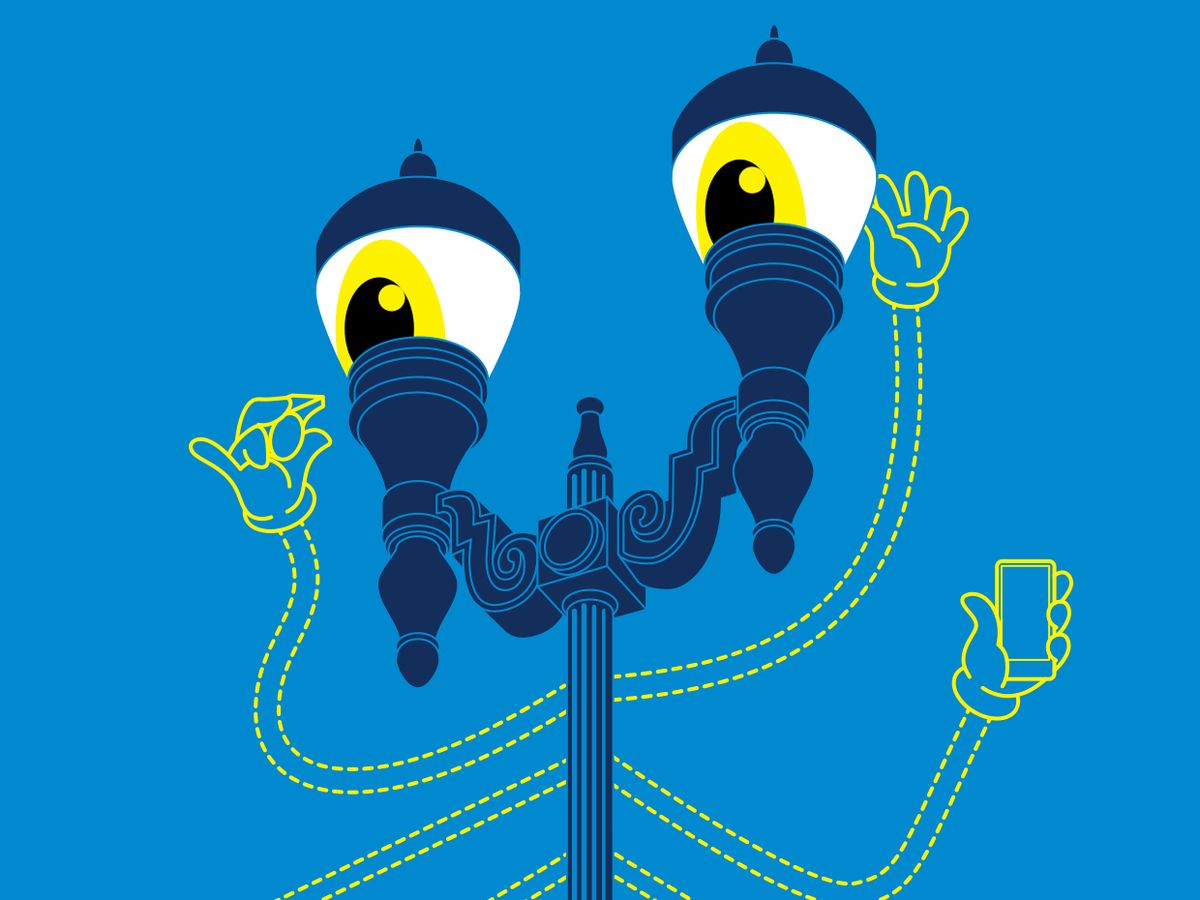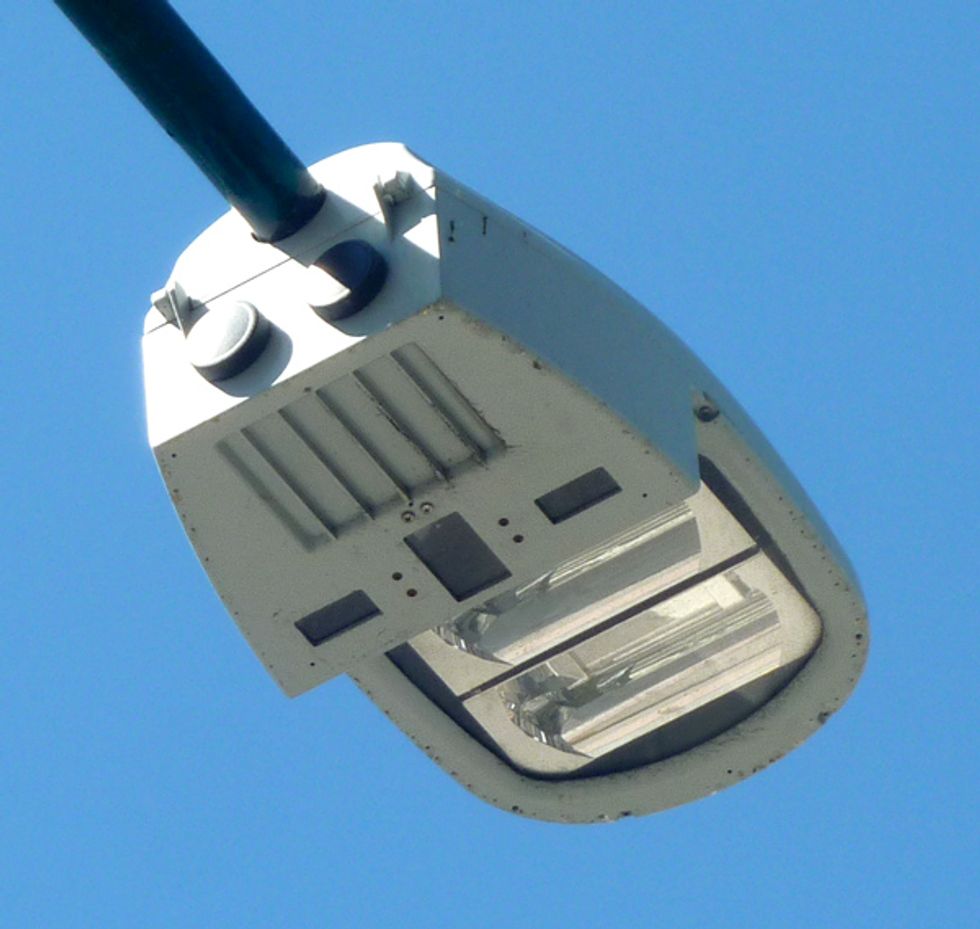San Diego Installs Smart Streetlights to Monitor the Metropolis
Sensor-laden streetlights will spot parking spaces, listen for gunshots, and track air pollution

None of the people walking around San Diego’s East Village neighborhood one recent afternoon were looking up at the streetlights (except me). And if they had, they likely wouldn’t have noticed that some of these lights were a little thicker around the middle than others, or that some lanterns topping old-style lampposts had a clear glass panel here and there.
But unbeknownst to the people below, those streetlights were looking—and listening—all around them, while also monitoring temperature, humidity, and other characteristics of the air.
And this year, what was a test network of just 50 smart, sensor-laden streetlights will explode to cover most of the populated parts of San Diego. By sometime in May, about 3,200 of the sensing lights, designed and operated by Current, a subsidiary of General Electric, will each monitor an oval area of roughly 36 by 54 meters (120 to 180 feet). The network’s first job will be pointing out vacant parking spots to drivers and, potentially, alerting traffic enforcement officers to illegally parked cars. Later in the year, city officials expect, the sensor data will be used in other ways, some by the city and some by software developers creating new services for residents and visitors.
For starters, the city “expects to learn what intersections are the most dangerous and need to be redesigned, based on information on near misses, not just the accident data. It’s a whole new way to improve pedestrian safety,” said David Graham, San Diego’s deputy chief operating officer.
Also, he says, the streetlights could easily be hooked into the city’s existing ShotSpotter network, which automatically locates the source of gunfire, increasing ShotSpotter coverage from just 10 square kilometers (about 4 square miles) to a much broader area. The sensing lights could detect other sounds, too, and automatically alert police to dangerous situations, by recognizing the sound of broken glass or a car crash, for instance. And they’ll be able to monitor intersections and note when traffic backs up—information that might one day be used to adjust traffic signals.

All that will be just the beginning, says Austin Ashe, Current’s general manager for intelligent cities, because much of the data gathered by the streetlight Internet of Things (IoT) network will be publicly available, and the city will allow software developers to build apps that use the data. To spark development of such apps, the city, GE, and other sponsors have held multiple hackathons. Apps emerging to date include one that identifies the quietest walking route (for people who want to have conversations while strolling); a “digital cane” app designed to use traffic and location data to help visually impaired people cross the street; an app that allows food truck drivers to find locations with available parking spaces and a history of high pedestrian traffic; and a way to identify interesting events in real time, finding hot spots by tracking where pedestrians are congregating or heading.
All this is just a hint of what’s to come, say Ashe, Graham, and many entrepreneurs eager to get their hands on streetlight data. And we’re talking about a lot of data. Each IoT streetlight incorporates a package of hardware that Current calls CityIQ. It includes an Intel Atom processor and half a terabyte of memory; Bluetooth and Wi-Fi radios; two 1080p video cameras for video, still images, and computer vision analytics; two acoustical sensors; and environmental sensors that monitor temperature, pressure, humidity, vibration, and magnetic fields. Much of the data gathered will be processed on board, with selected events or streams of data uploaded to GE’s Predix cloud through AT&T’s LTE network.
Along with the sensing streetlights, San Diego will be replacing an additional 14,000 of the city’s more than 40,000 streetlights with energy-efficient LED lamps that can communicate with one another and operators and allow brightness adjustments to save energy. The price tag comes in at US $30 million, but it won’t break the budget, says Graham, because it will save 60 percent in the cost of powering the city’s lights. Over the next 13 years, these savings will more than cover the hardware and cloud-computing services required for the streetlight IoT. A financing arrangement spreads out the payments, so the savings stay ahead of the costs.
San Diego won’t have the only CityIQ network for long. GE is planning to roll out its second installation in Atlanta, Ashe says, and in partnership with AT&T, GE has submitted proposals to other U.S. cities. Singapore has announced plans to install 2,000 sensor-laden streetlights by the end of this year. And a number of cities have extensive camera-based surveillance networks, including London, Chicago, and Chongqing, China, though none include the kind of comprehensive sensor packages being installed on San Diego streetlights, Ashe says.
“We think streetlights are the place to do this [observation],” he says, “because they have power, ubiquity, and the perfect elevation—high enough to cover a reasonable radius, low enough to capture a lot of important data.”
But what’s really important about the San Diego network, Ashe says, is that most of the data will be publicly available. “San Diego is redefining the smart city,” he says. “Previously, smart cities were about what city hall needed and wanted. In this approach, data will be given to multiple commercial vendors, universities, and entrepreneurs at the same time—and the uses that come out of this will be extraordinary.”
This article appears in the January 2018 print issue as “San Diego’s Streetlights Get Smart.”